The Only Food List You’ll Ever Need for Healthy Ageing?
What a 30-year Harvard study reveals about the foods that shape your future health
It’s a safe bet you’re here because you care about your future self - you want the choices you make today to pay off in extra years of strength, sharpness, and independence.
Trouble is, the rules keep changing.
One minute it’s “Mediterranean or bust,” the next it’s “cut all carbs,” and somewhere in between there’s an influencer shouting about raw milk.
No wonder the cheesecake starts calling your name. (Or is that just me?)
Here’s the thing: we actually do know what a healthy diet looks like. The finer points can be debated, but the big picture has been remarkably consistent for decades.
And earlier this year, a group of researchers from Harvard and elsewhere published a fascinating follow-up in Nature Medicine. They tracked over 105,000 Americans for up to thirty years, comparing popular eating patterns - from the Mediterranean and DASH diets to vegetarian and anti-inflammatory - to see which best predicted healthy ageing.
Healthy ageing, in their book, meant:
Staying mentally sharp
Physically capable
Free of major chronic disease
In good mental health
And making it past 70 with all of the above intact
The “winner” among diets? The Alternative Healthy Eating Index (AHEI). A solid choice… but given it was developed by Harvard on the same population they studied, it’s a bit like marking your own homework.
The real gold isn’t which diet topped the chart - it’s the ranked list of individual foods linked to thriving in later life.
I’ve broken them into two simple groups for you:
Green list: the foods that stack the odds in your favour
Red list: the ones that chip away at future health
There are also a few odd ones, but we'll get to that.
Let’s start with the ones you want on your plate every day.
The Fantastic Fifteen - Foods to Eat Every Day
Here’s the headline you’ve been waiting for - the Harvard healthy-ageing leaderboard.
These are the 15 foods most strongly linked to staying healthy, strong, and independent for longer. The list runs left to right, row by row - just like reading a book - with fruit taking the top spot.
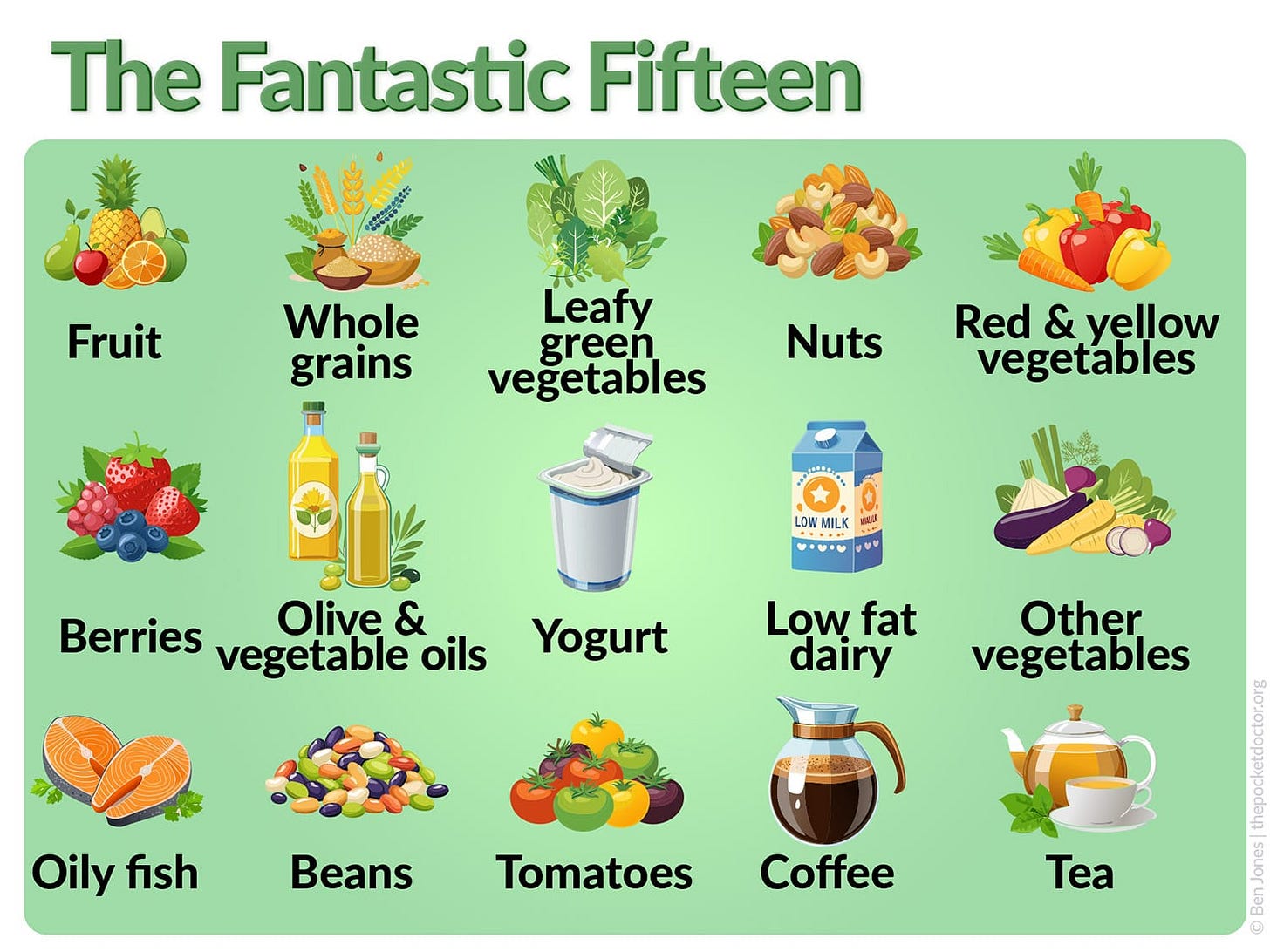
No big surprises here - and that’s exactly the point. These are the foods you’ve heard about for years. What matters is how often they show up on your plate.
Ask yourself:
How many of your meals last week featured these?
Do they dominate your shopping basket, or are they the exception?
In an ideal world, you’d tick off most of this list every day. The only exception is oily fish: as we’ve covered before, two to four portions a week is the sweet spot.
This is the kind of ranking worth taping to your fridge. And yes, it’s easier said than done - I’m still lagging on leafy greens. There’s a bag of frozen spinach in my freezer that’s been there so long it may have earned squatters’ rights.
If you’ve got a go-to leafy green recipe that isn’t another “throw it in a smoothie” suggestion, hit reply and rescue me.
The Bottom of the List - Foods to Avoid
Now for the foods at the other end of Harvard’s healthy-ageing leaderboard - the ones most strongly linked with poorer health as we get older.
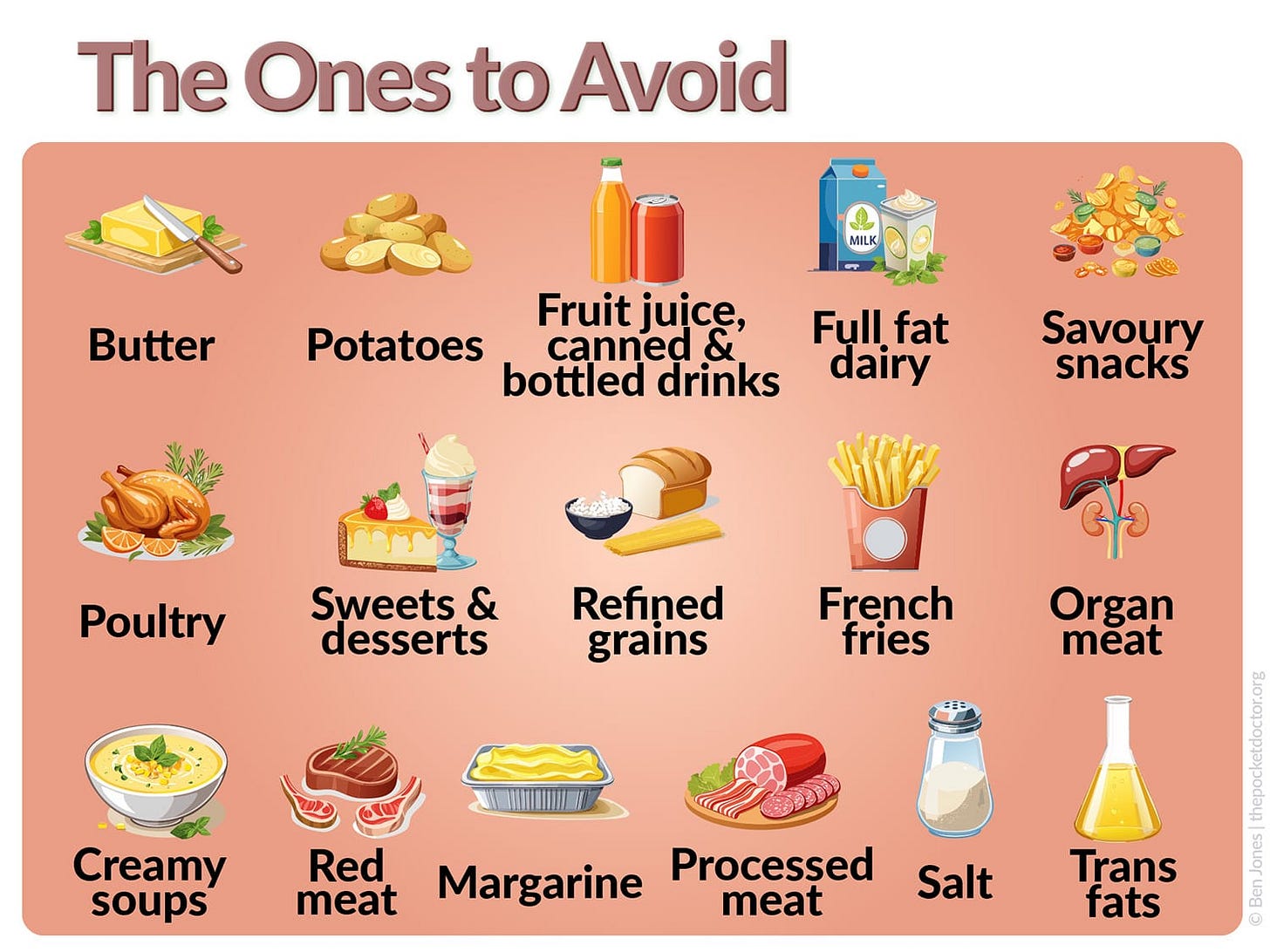
It’s another ranked list, with butter at the “best of a bad lot” end and trans fats at the very bottom.
If you eat a typical Western diet, most of your food comes from here. These are the heavily marketed foods you see in adverts, on billboards, and in school canteens - but rarely on the same shelf as the Fantastic Fifteen.
And here’s the rub: these are also the foods we’ve been trained to crave.
They’re what we reach for to celebrate, to commiserate, to cheer ourselves up after a rough day. No one binges on beans or feels a sudden urge for a red pepper - but decades of brilliant food marketing have hardwired our brains to desire the salty, sugary, fatty items on this list.
A few entries spark debate:
Red meat - I know some of you will bristle seeing it here. There’s a vocal camp arguing that meat is the cornerstone of health. But in this study (and most others), higher red-meat consumption was linked to worse ageing outcomes. Whether the harm comes from the meat itself or the way it’s cooked is still open to question. High-temperature methods like grilling, roasting, and frying generate harmful compounds - so if that’s how you cook your meat, the distinction may be academic.
Margarine is ranked even lower than butter. Over the long study period, margarine often contained trans fats, which are unequivocally harmful. Today’s versions typically no longer contain trans fats (though they may, especially in the US, where regulations are laxer) but are often made with synthetic interesterified fats, poorly studied in humans but harmful in animal models. Better? Safe? We don’t know.
The practical takeaway: the further along this list, the more it chips away at your future health. And if you, like me, still have an ingrained belief that bread needs a smear of butter or margarine, it may be time to let that go. Your arteries (and your future self) will thank you.
The Muddled Middle - Food with Footnotes
Not every food in Harvard’s ranking fell cleanly into the “eat more” or “eat less” camps. A handful landed mid-table, and for most, the story is in the fine print.
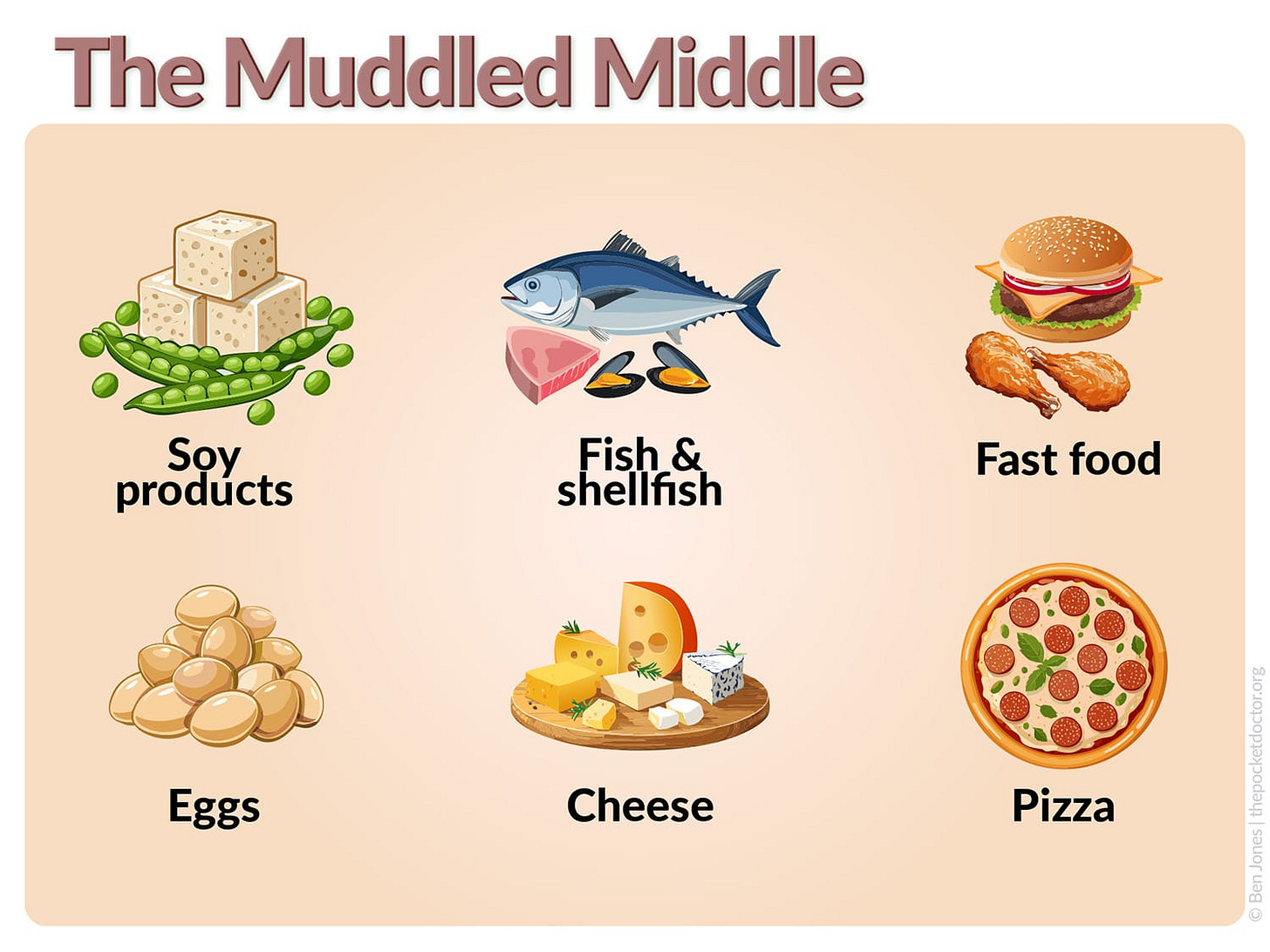
It's odd to find these in the middle, right?
Which of these would you have put firmly in the “good” or “bad” column?
Soy products - This category lumps together very different foods: nutrient-dense options like edamame beans and unsweetened soy milk, and far less healthy versions like deep-fried tofu in salty sauces. That mix dilutes the average. Another factor: soy is still relatively uncommon in the US, so there’s less long-term data to work with. If you enjoy soy, stick to the minimally processed end of the spectrum.
Fish & shellfish - This is all fish, not just the oily fish in the green list. In the US, much of it is breaded, battered, fried, or heavily charred, which cancels out most of the benefits. Swap deep-fried shrimp for baked salmon, and you’ll push this choice firmly into the green.
Fast food - In most studies, this sits deep in the red zone. Here it ranked slightly better, likely because of the social factor: grabbing a burger with friends is still social eating, and strong social connections protect health. Unfortunately, a social setting doesn’t cancel out the salt, sugar, and processed fats - so see this more as an occasional social treat than a health food.
Eggs - Always contentious! A 2021 study of over 500,000 Americans found that high egg intake (about 5/week) was linked to a 17% higher risk of early death, likely driven by the cholesterol in the yolk. People eating only egg whites saw a 7% lower risk. Cooking method matters too: in the US, eggs are often fried and paired with processed meats, which pushes them toward the red list.
Cheese - Hard, fermented, and blue cheeses have benefits; soft and processed cheeses do not. This study grouped them all together, so a wedge of Stilton and a plastic-wrapped cheese slice both counted the same. In real life, they don’t.
Pizza - A chameleon food if ever there was one. A white-flour crust with soft cheese and processed meat? Solidly red. A whole-grain base topped with vegetables, oily fish, and drizzled with olive oil? Much greener. The study reflects the average US pizza - and it’s not the veggie-loaded kind.
Bottom line: most “middle” foods ended up here because of how they’re prepared, what they’re served with, and how often they’re eaten. Change the context, and you can often change where they belong on the list.
Turns out, most of these can move up or down the list depending on what you do to them. Unfortunately, “smother in cheese” isn’t the winning strategy I hoped for.
So, three lists. One green, one red, one grey and messy.
And this, to me, is the real gold from Harvard’s 30-year study - you don’t have to follow a named diet to reap the benefits. You just need to tip your plate toward the foods that show up in the green list more often than the red. The patterns are clear enough that you can start today, no spreadsheet or PhD required.
That’s where this week’s tweak comes in.
Health Tweak of the Week
The real win here isn’t the perfect diet - it’s knowing that each bite moves you in one of two directions. That’s powerful, because it means your next forkful matters more than the last one.
When Harvard researchers followed more than 105,000 Americans for up to thirty years, they were able to rank a range of foods for their links to healthy ageing.
Based on this study - and the findings are in agreement with most others - here's an infographic you can stick to the door of your fridge or save on your phone.
The higher on the list, the better the food will protect your future.
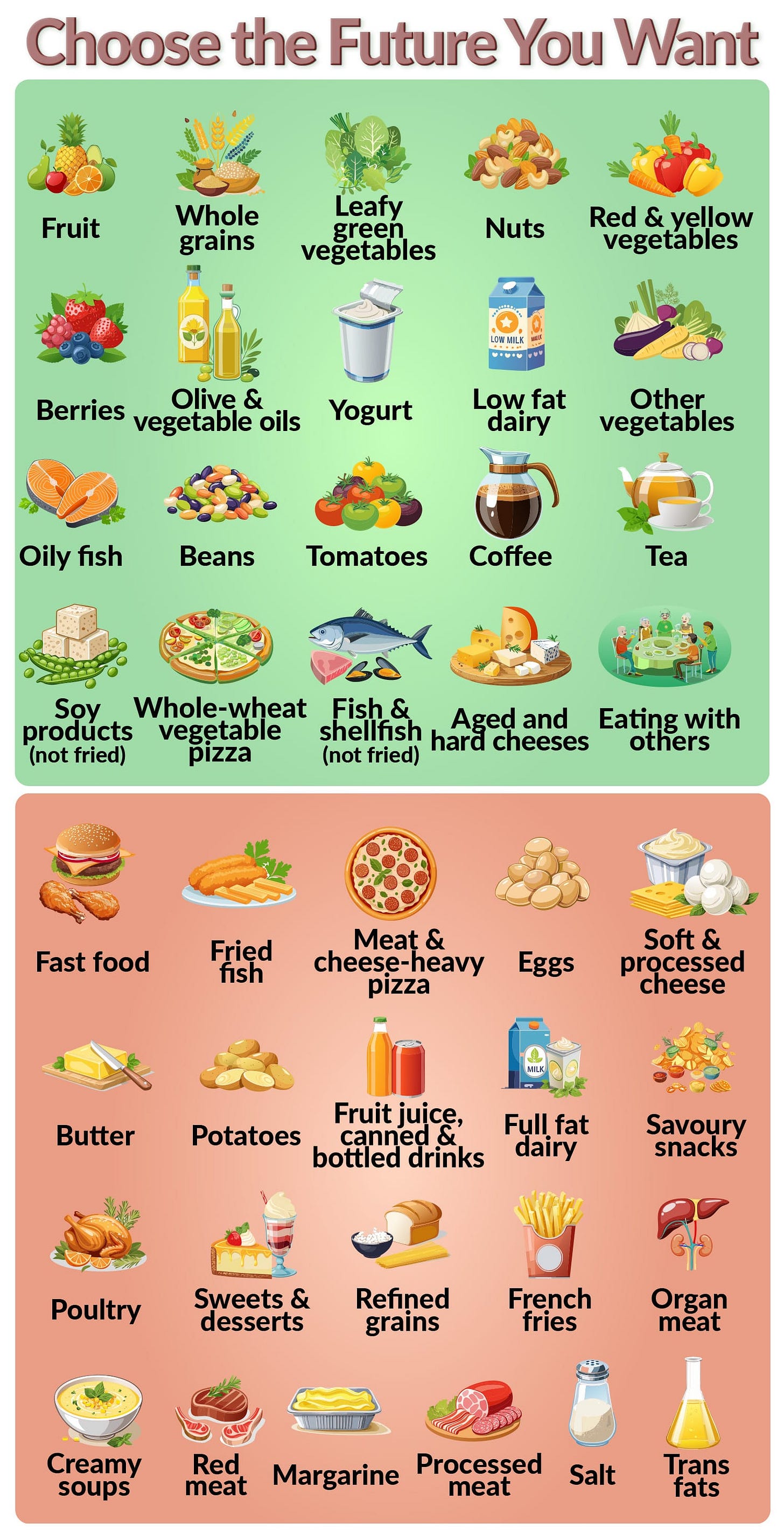
Every green-box choice is a deposit into your future strength, health, and independence. It’s how you keep carrying your own shopping, walking up stairs without stopping, and living on your own terms for as long as possible. Red-box choices do the opposite - they chip away at those abilities, often in ways you won’t notice until it’s too late to get them back.
You don’t have to overhaul everything at once. Just start tilting the balance. Swap one red-box food for a green-box food today, then do it again tomorrow. These small wins add up - meal by meal, month by month - until they’ve reshaped your future in ways that fad diets and quick fixes never will.
The truth is, every bite points you in one of two directions. One path leads to more years of strength, sharpness, and independence. The other leads to decline that feels “sudden” but was really built one meal at a time.
The choice is yours - and you’ll make it three times a day.
🎧 If you’d rather listen while your spinach defrosts…
🎙️ This week’s episode of the One Health Tweak a Week podcast takes a different angle on healthy ageing - and your kitchen staples might be the star players:
The green list foods to make daily staples
The red list foods that quietly chip away at your future health
The muddled middle foods whose impact depends on how they’re prepared and served
How to use this simple list to guide your choices without following a rigid “named” diet
👉 Listen now while your leafy greens thaw
(Psst: these episodes are free for now, but won’t be forever. Paid subscribers help keep this newsletter going - and get bonus content, private member chat, and insider Q&As.)
👉 What’s next?
💬 Which of the green-list foods are your daily no-brainers - and which feel like a chore? Drop a comment and let’s compare notes.
📢 Know someone who thinks French fries are a vegetable? Forward this to them - it might just change their shopping list.
❓ Got a favourite way to make leafy greens irresistible? Hit reply - I'll bet I'm not the only one looking for inspiration!
🔒 Want smarter tweaks every Saturday? Upgrade to a paid subscription for bonus content, private member chat, Q&As, and the satisfaction of supporting evidence-based wellness writing that’s researched, not recycled.
This coming week, I have friends visiting from the US, and we're off to explore a few Viking relics. Given that it takes me a day or two to research and write each newsletter, there'll be no newsletter next week, but I’ll be back the following Saturday with your next tweak - and a firm decision on whether horned helmets were ever a good idea.
Until next time - stay curious, stay grounded, and keep steering your plate toward the green list.
– Ben




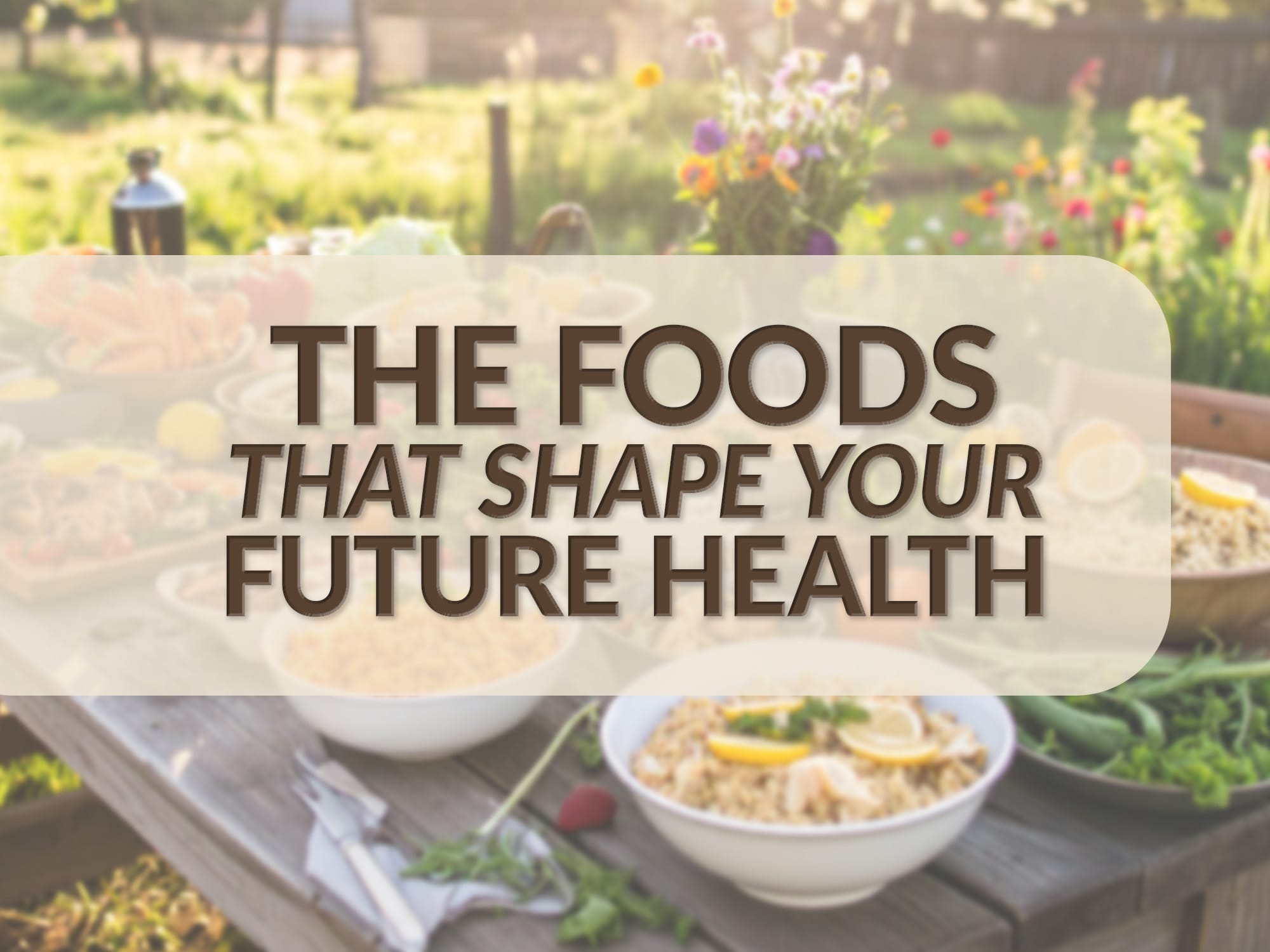

How did poultry end up where it did? I thought it was okay? Since I cannot tolerate any fish, it only leaves me with beans as the main source of protein. Secondly, are sweet potatoes in the same category as white potatoes or are they part of the yellow/orange vegetables? Thanks for the info.
At least two meals a day begin with a large soup / salad bowl with a LARGE handful of packaged fresh baby spinach or baby arugula or kale or “spring mix” which are moistened with several spritses of liquid amino acids (flavored or not). Microwaved for 33 to 39 seconds. If the greenery is at all large-leafed I will break / cut it into smaller pieces before microwaving. On top of this leafy green bed I then add almost any / every type of food.
This makes the greens delicious and makes everything else added to my bowl delightful.
By the way, over the almost 12 months of having made this leafy greens change —along with several other important dietary modifications — I have dropped total cholesterol to 80s, LDL to 20s, weight by 25 lbs; as a type 1 diabetic for 75 years, hemoglobin A1c in mid 5s and Time in Range in mid-high 80s.
I follow your weekly Sat. column avidly, and find insights and affirmations that bring joy to my heart — and many other parts of my body !!
— Jack